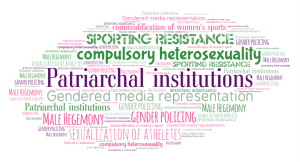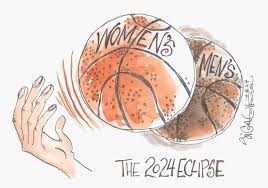1
Section One: The Fundamentals
A) What do we know about sport? What are common assumptions we make about sport and society?
| When I think of the phrase “sports transcends politics” I think about how this is untrue for many countries. The opposite is ever so prevalent today; sport is as deeply embedded in politics as politics is deeply embedded in sports. Today more so than ever, sports are used to influence political relations and push certain ideologies. As much as I would love to say these two worlds are separate, unfortunately, this is not the case. One of the most common examples of politics embedded in sports, is the Olympics. The Olympics is no stranger to using sports for diplomatic gain and influence, although the IOC would strongly disagree. Many countries use hosting the Olympics as a stepping stone into legitimization on the international stage, using the games as a way to showcase their country’s power. Countries also use the games to send messages to other nations, for example, the USA’s boycott of the 1980 Moscow Olympics was used to send a political message to the Soviet Union a. after their invasion of Afghanistan In addition to sports being used as political tool, athletes are also becoming political figures, using their stage to become advocates and send political messages. An example of this is former 49ers Quarterback, Colin Kaepernick who chose to kneel during his country’s national anthem in a protest against police brutality, and Megan Rapinoe who used her power to advocate for the national women’s soccer team to receive the same compensation as the men’s. Sports is not immune to politics nor does it transcend politics, but it does have the power to create meaningful political change. |
Exercise 3: Notebook prompt
What are some other metanarratives about sport that you are familiar with? Find an image or video clip or draw something yourself that captures this idea…
So what? Why does any of this matter? Does it matter? As something we grow up with – live with – play through – we don’t often interrogate the meanings of sport, and perhaps we don’t want to.
But being aware of these assumptions and metanarratives is especially important, I would argue, because of the centrality of sport to our everyday lives, the role that sport plays in shaping our childhood and worldviews and….. [finish that thought]
Some other metanarratives about sport that I am familiar with include:
and…as an adult I can see how differently sports have impacted my views, but also I find it interesting to see how age and experience has changed my views entirely. Now, I find the metanarrative that achievement in sports comes from a relationship between talent and tenacity to be detrimental. Growing up, I was mediocre in the sport I played, was good enough to compete but not quite good enough to follow through with it past highschool, which is something I knew but it didn’t stop me from working hard, I knew I had the tenacity but when I saw the way other people seemed to have this talent I didn’t seem to possess it made me want to pursue the sport less, thinking to myself that maybe I was unlucky and didn’t get the talent portion I needed to be great. I also see the other side of it now, which as a child I never would think of, but the financial side of sports. I wish the narrative was true, that hard work is enough to pay off, but I have become increasingly aware of how children of poverty are far less likely to excel at sports due to sports being inaccessible. I am more critical now than I was a child, thinking to myself when watching a hockey game, are these players “exceptional talents” or are they simply the children who’s parents could afford private training sessions, hours of practice, equipment, and high level of hockey?
|
B) What is social justice?
Exercise 4: Padlet Prompt
Think back to the last section and try to look at some of the ideas we discussed differently. How might sport and social justice actually co-exist?
Record any images, video clips, or gifs you added to the padlet and identify a point of intersection between sport and social justice (can be an issue or a barrier or a debate or something you would like to explore in more depth in this course) . Screenshot or paste in your response below.
| A key point of intersection between sport and social justice can be seen in the creation of women’s professional leagues. These leagues provide women with equal opportunities to showcase their talent, gain recognition, and earn fair compensation for their athletic abilities, challenging the long-standing gender disparities in professional sports. The establishment of such leagues not only advances gender equality in sport but also promotes societal shifts towards inclusivity and equity. An example of this and something that sits close to my heart is the creation of the Professional Women’s Hockey League. Although there are still strides to be made, the creation of this league has proven progressive for women within the sport. I believe this is a great step towards women’s representation; however it is only the beginning, as significant increases to broadcasting and funding can be made. Despite their inaugural season showing greater audience numbers than expected there are still people who believe that professional sports belong to men, showcasing that there is lots of work to be done to change this narrative.
|
C) Social Justice Reading
(note: this activity is optional!)
D) KINESIOLOGY AND SOCIAL JUSTICE
Exercise 5:
Exercise 6:
What are the implications of bodies-at-risk discourse and the refusal to understand the health gap from a social justice perspective, according to the authors of this article?
|
|
Section Two: Sport Feminism
Exercise 7: Notebook Prompt
What is feminism? What does it mean to you? Choose one of the images below and explain how it captures your understanding of feminism (or find one that does speak to you and paste this into your pressbook with an explanation of why it matters to you.
| For this prompt, I think my answer can be more easily explained with a song rather than a photo. There is a song that has gone viral within the last few years, being used in videos of woman talking about topics such abusive relationships, misogyny, reproductive rights, and more. Some of the lyrics include:
“All day, every day, therapist, mother, maidNymph then a virgin, nurse then a servantJust an appendage, live to attend himSo that he never lifts a finger24∕7, baby machineSo he can live out his picket fence dreamsIt’s not an act of love if you make herYou make me do too much labour” To me feminism is about choice, it’s about women having their own choices of how they wish to live, without the influence of a man. This song is a very moving song by Paris Paloma called “Labour” where she calls out the narrative that women are to be servants, homemakers and the pillars of male success without recognition. To me feminism is the recognition that woman are not alive for the sole purpose of pleasing men, and should be able to access equal opportunities as we are all human. |
Exercise 8: Notes Prompt (optional)
NB: Cornell notes is a great resource that teaches effective notetaking. Unfortunately, our system can’t save notes taken in the H5P app, so this is fully optional.
Exercise 9: Crossword Activity
Exercise 10: Padlet Prompt

|

| I feel with the rise of women in sports and women professional sports leagues we are at a turning port for women in sport right beneath our eyes. Unfortunately I am unfamiliar with the basketball word and cannot speak to the WNBA, but another league I am more familiar with that I think is encompassing this same idea is the Professional Women’s Hockey League. Growing up in Canada, hockey is our sport. As a young woman, I never played hockey but I was surrounding by incredibly talented women who do, and knowing that there was no higher league for them to strive for besides playing hockey at the post secondary level made me angry. The introduction of the PWHL has shown a lot of people around the world that people care about women in sports, and people want to see them thrive at the professional level. The landscaping is changing, professional sports are no longer seen as men-only events. The evidence has been there, it has just taken years of fighting to reach the levels where the public can be shown the data. For example, when Toronto’s PWHL team played for a season at the Mattamy Athletics Centre, a small semi-professional rink, that holds a mere 2,600 people, the people of the GTA were upset as the number of people wanting to see this team play far exceeded 2,600 people. This pushed for change as the team was awarded a spot at the Coco Coliseum which holds 8,100 fans. The evidence doesn’t stop there, as the team continues to show unwavering support, selling out the Scotia Bank Arena each time they hold a game there, which holds a respectable 20,000 fans. So yes, I care deeply about women’s sports, and based on the evidence, thousands of people do too.
|

